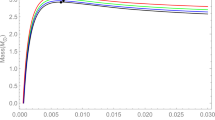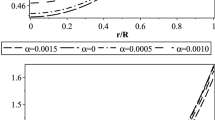Abstract
In this article, we have studied the solutions of Einstein–Maxwell field equations for compact objects in the presence of net electric charge. Interior physical 3-space is defined by Vaidya–Tikekar metric in spheroidal geometry. The metric is characterised by two parameters, namely, spheroidal parameter K and curvature parameter R. The nature of the interior fluid is considered to be anisotropic. Assuming strange matter equation of state (EOS) in the MIT Bag model for the interior matter content, namely, \(p=\frac{1}{3}(\rho -4B)\), where B is the Bag constant, we determine various physical properties of the charged compact star. We have taken the value of surface density \(\rho _{s}\) \((=4B)\) as a probe to evaluate the mass–radius relation for the compact star in the presence of net electric charge and using the range of B necessary for possible stable strange matter. It is interesting to note that in this model there exist a maximum radius of a star which depends on B. We further note that compactness of the star corresponding to the maximum radius always lies below the Buchdahl limit \((<\frac{4}{9})\) for the maximum allowed value of the pressure anisotropy and electromagnetic field. Energy and causality conditions hold good throughout the star in the presence of charge also. Prediction of mass of the strange stars is possible in the present model. We have determined mass, radius, surface red-shift and other relevant physical parameters of the compact objects.




























Similar content being viewed by others
References
R C Tolman, Phys. Rev. 55, 364 (1939)
J R Oppenheimer and G M Volkoff, Phys. Rev. 55, 374 (1939)
P C Vaidya and R Tikekar, J. Astrophys. Astron. 3, 325 (1982)
R Tikekar, J. Math. Phys. 31, 2454 (1990)
S Mukherjee, B C Paul and N K Dadhich, Class. Quantum Gravit. 14, 3475 (1997)
M Dey, I Bombaci, J Dey, S Ray and B C Samanta, Phys. Lett. B 438, 123 (1998); Addendum 447, 352 (1999); Erratum 467, 303 (1999)
X D Li, I Bombaci, M Dey, J Dey and E P J Van del Heuvel, Phys. Rev. Lett. 83, 3776 (1999)
R Sharma, S Mukherjee, M Dey and J Dey, Mod. Phys. Lett. A 17, 827 (2002)
R Tikekar and K Jotania, Int. J. Mod. Phys. D 14, 1037 (2005)
P K Chattopadhyay and B C Paul, Pramana – J. Phys. 74, 513 (2010)
R Sharma and S Mukherjee, Mod. Phys. Lett. A 16, 1049 (2001)
R Sharma, S Mukherjee and S D Maharaj, Gen. Relativ. Gravit. 33, 999 (2001)
R Sharma and S Mukerjee, Phys. Lett. A 38, 2535 (2002)
R Sharma, S Mukerjee and S D Maharaj, Mod. Phys. Lett. A 15, 1341 (2000)
R Sharma, S Karmakar and S Mukherjee, Int. J. Mod. Phys. D 15, 405 (2006)
S Karmakar, S Mukherjee, R Sharma and S D Maharaj, Pramana – J. Phys. 68, 881 (2007)
Ch Kettner, F Weber, M K Weigel and N K Glendenning, Phys. Rev. D 51, 1440 (1995)
J Madsen, Lect. Notes Phys. 516, 162 (1999)
N Itoh, Prog. Theor. Phys. 44, 291 (1970)
A R Bodmer, Phys. Rev. D 4, 1601 (1971)
E Witten, Phys. Rev. D 30, 272 (1984)
J Kapusta, Finite-temperature field theory (Cambridge Univ. Press, Cambridge, 1994) pp. 163–165
E Farhi and R L Jaffe, Phys. Rev. D 30, 2379 (1984)
L Herrera and N O Santos, Phys. Rep. 286, 53 (1997)
R Kippenhahn and A Weigert, Stellar structure and evolution, 2nd Edn (Springer-Verlag, Berlin, 1990)
Fifty years of nuclear BCS: Pairing in finite systems edited by R A Broglia and V Zelevinsky (World Scientific Publishing Co. Pvt. Ltd., 2013)
D Page, J M Lattimer and M Prakash, Novel superfluids edited by K H Bennemann and J B Ketterson (Oxford University Press, 2014) Vol. 2, p. 505
R F Sawyer, Phys. Rev. Lett. 29, 382 (1972)
A I Sokolov, JETP 79, 1137 (1980)
H Reissner, Ann. Phys. 50, 106 (1916)
G Nordström, Verhandl. Koninkl. Ned. Akad. Wetenschap., Afdel. Natuurk. 26, 1201 (1918)
L K Patel, R Tikekar and M C Sabu, Gen. Rel. Grav. 29, 489 (1997)
R Tikekar and G P Singh, Gravit. Cosmol. 4, 294 (1998)
P K Chattopadhyay, R Deb and B C Paul, Int. J. Mod. Phys. D 4, 294 (2012)
A Krasinski, Inhomogeneous cosmological models (Cambridge University Press, Cambridge, 1997)
A Treves and R Turolla, Astrophys. J. 517, 396 (1999)
S Rosseland, Mon. Not. R. Astron. Soc 84, 720 (1924)
A F Zakharov, F De Paolis, G Ingrosso and A A Nucita, Astron. Astrophys. 442, 795 (2005)
C W Misner and D H Sharp, Phys. Rev. 136, B571 (1964)
H A Buchdahl, Phys. Rev. 116, 1027 (1959)
M K Mak and T Harko, Proc. R. Soc. London A 459, 393 (2003)
K Dev and M Gleisser, Int. J. Mod. Phys. D 13, 1389 (2004)
M Chaisi and S D Maharaj, Gen. Relativ. Gravit. 37, 1177 (2005)
R Tikekar and V O Thomas, Pramana – J. Phys. 52, 237 (1999)
S D Maharaj and R Maartens, Gen. Relativ. Gravit. 21, 899 (1989)
R Sharma, S Mukherjee and S D Maharaj, Gen. Relativ. Gravit. 33, 6 (2001)
L Herrera, Phys. Lett. A 165, 206 (1992)
R Sharma, S Karmakar and S Mukherjee, Int. J. Mod. Phys. D 15, 3 (2006)
B C Paul, P K Chattopadhyay and S Karmakar, Astrophys. Space Sci. 356, 327 (2015)
S Karmakar, S Mukherjee, R Sharma and S D Maharaj, Pramana – J. Phys. 68, 6 (2007)
K B Goswami, A Saha and P K Chattopadhyay, Astrophys. Space Sci. 365, 141 (2020)
R Sharma, N Dadhich, S Das and S D Maharaj, Eur. Phys. J. C 81, 79 (2021)
Ya B Zeldovich and I D Novikov, Relativistic astrophysics, in: Stars and relativity (University of Chicago Press, Chicago, 1971) Vol. 1
M L Rawls, J A Orosz, J E McClintock, M A P Torres, C D Bailyn and M M Buxton, Astrophys. J. 730, 25 (2011)
F Özel, T Güver and D Psaltis, Astrophys. J. 693, 1775 (2009)
P B Demorest, T Pennucci, S M Ransom, M S E Roberts and J W T Hessels, Nature 467, 1081 (2010)
J Ponce de León, Gen. Relativ. Gravit. 19, 797 (1987)
H Abreu, H Hernández and L A Núñez, Class. Quantum Gravit. 24, 4631 (2007)
H Heintzmann and W Hillebrandt, Astron. Astrophys. 38, 51 (1975)
C E Rhoades and R Ruffini, Phys. Rev. Lett. 32, 324 (1974)
P C C Freire, S M Ransom, S Bégin, I H Stairs, J W T Hessels, L H Frey and F Camilo, Astrophys. J. 675, 670 (2008)
C G Böhmer and T Harko, Class. Quantum Gravit. 23, 6479 (2006)
B V Ivanov, Phys. Rev. D 65, 104001 (2002)
Acknowledgements
KBG and BD are thankful to CSIR for providing the fellowship vide No. 09/1219(0004)/2019-EMR-I and 09/1219(0005)/2019 EMR-I, respectively. They are also thankful to the anonymous referee for important suggestions on our article.
Author information
Authors and Affiliations
Corresponding author
Rights and permissions
About this article
Cite this article
Saha, A., Goswami, K.B., Das, B. et al. Effect of charge on the maximum mass of the anisotropic strange quark star. Pramana - J Phys 97, 10 (2023). https://doi.org/10.1007/s12043-022-02477-x
Received:
Revised:
Accepted:
Published:
DOI: https://doi.org/10.1007/s12043-022-02477-x




